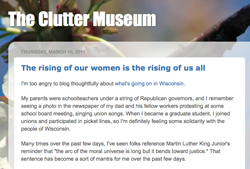Cross-posted at The Multicultural Toybox
I grew up with Sesame Street. As a child, I loved the colorful sketches and songs, and pretty much any scene that had a Muppet in it, but especially if it featured my then-favorite, lovable, furry old Grover. (Today I’m more of a Cookie Monster fan.)
These days, when I watch Sesame Street with my 5-year-old, I enjoy it for a completely different reason: its gospel of radical acceptance. Long before Lady Gaga had her hit “Born This Way,” Sesame Street preached both self-acceptance and acceptance of others, no matter what their attributes or quirks.
I think this is, at heart, what troubles conservative critics of the show. Here’s the latest attack on Sesame Street; it’s expressed during a panel moderated by Sean Hannity, and it aired on FOX on June 1:
Ben Shapiro comments on Sesame Street
I was especially interested in these bits of the conversation:
Ben Shapiro, author of Primetime Propaganda: I talked to one of the guys who was originally at Children’s Television Workshop originally, and he said that the whole purpose of Sesame Street was to cater to black and Hispanic youths who don’t have reading literature in the house. There’s kind of this soft bigotry of low expectations that’s automatically associated with Sesame Street. If you go on the Sesame Street website, it talked about ‘when you’re bringing up your child, make sure that you use gender neutral language. Make sure that you give your boys dolls and make sure that you give your girls firetrucks.
Ah, there’s so much to unpack here, isn’t there? First, it’s too easy to dismiss a desire to cater to underprivileged children of color as a “soft bigotry of low expectations.” If we look at the actual history of Sesame Street‘s founding, we find the show was the first to be structured entirely on sound educational research.
Sesame Street was (and is) driven by data, not sentiment
For anyone interested in the history of television, in children’s informal learning, or just in the story of how the first children’s educational television developed, I highly recommend G is for Growing: Thirty Years of Research on Children and Sesame Street.* In the first essay in the book, Edward Palmer (an early member of the Children’s Television Workshop staff) and Shalom Fisch tell the story of how CTW and Sesame Street came to be, and they emphasize how thoroughly the show relied on research rather than on some liberal agenda or sentiment:
What distinguished Sesame Street (and, to a lesser degree, the contemporaneous Mister Rogers’ Neighborhood) was the combination of narrowly focused and expertly planned educational curriculum, its attempt to forge the most effective possible methods of televised teaching, and its accountability to bring about rigorously measured educational results.
That isn’t to say that Sesame Street isn’t a product of a particular historical era; it very much is, and Palmer and Fisch explain how the confluence of the Civil Rights movement, greater government interest in and funding of education, and the rapid growth of public broadcasting led to the development of the first show of its kind. Specifically, they write,
CTW’s sole initial mandate was to create, broadcast, promote, and evaluate an experimental educational television series of 130 hour-long programs that would seek to advance the school readiness of 3- to 5-year-old children, with special emphasis on the needs of youngsters from low-income and minority backgrounds.
Palmer and Fisch cite research studies of the era, including those by Benjamin Bloom (1964), Carl Bereiter (1966), and Martin Deutch (1965), which taken together showed that:
- greater than fifty percent of “a child’s lifetime intellectual capacity” is formed by age 5;
- beginning in first grade, low-income children of color tested substantially lower than their white, middle-class peers;
- this education deficit continued to grow after first grade; and
- upon achievement of a basic level of literacy, children’s and adults’ opportunities for employment, as well as other opportunities, are vastly expanded.
CTW, Palmer and Fisch explain, “could not determine which group of children would cross that line [of literacy achievement] first, [but] it could—and did—aim to ensure that the maximum number possible would do so.” With 97 percent of households in the U.S. owning a TV, and most of them within the broadcast range of a public television station, CTW had the opportunity to improve the educational levels of millions of preschool children.
Sesame Street was not founded, as Ben Shapiro claims in his book and in his interview with Hannity, on low expectations and bigotry. It was founded, rather, on sound research into children’s learning, and its charge was to improve the educational readiness of all children (since children of all backgrounds would be in the broadcast area of the show), but with a special interest in providing additional support to children whose parents were unable, for whatever reason, to provide them with a first-class preschool education. The long-term goal was to help people rise out of poverty by giving children the early start they needed to develop as much intellectual capacity as they could by age 5.
But wait. . . there’s more
From the Hannity interview:
Sean Hannity: The values of young people today scare me. Cause we’re robbing them at easrlier and earlier ages of their childhood. They know more, they do more.
Kirsten Haglund: It’s very concerning. They have an access to more media at a younger age than at any other time of our nation’s history. And what you’re also seeing is more parents at work, away from their children, not monitoring what they look at. . .
Hannity: I grew up watching Green Acres and Andy Griffith.
Shapiro: Yeah, before the shift. That was before the shift.
“The shift”? The shift from portrayals of an era that existed only in white American nostalgia to. . . what? Television diversified its content and practices so quickly during the four decades following the first broadcast of Sesame Street that I’m not really sure what “the shift” signifies, other than “not rural or suburban whiteness.”
The interview continued with comments about how artists (including those involved in television production) are more liberal than the rest of a society. (I don’t buy that, but I’ll let it stand.) I immediately thought of how totalitarian regimes try to purge intellectuals and artists from their states. Ken Blackwell, however, identified a different target of such governments.
Ken Blackwell: If you look at any big government regime, any authoritarian, totalitarian regime, they attack two basic intermediary institutions–the family and the church. And that’s what’s happening in our culture right now. And it sets up an appetite for governmental largesse, government becomes the family. . .
Yes, because helping 3- to 5-year-old children establish greater intellectual capacity, with the long-term goal of ending cycles of urban poverty, is clearly an attempt to replace the child’s actual family with Big Brother.
The next couple of excerpts, however, deliver the coup de grâce:
Hannity: Liberals. . .feel like they can circumvent the values of parents when they go to school, teaching ’em things that they themselves are teaching the opposite of. They don’t do the basics, reading, writing, and math. . .
If liberals don’t like the basics–reading, writing, and math–why has the Obama administration embraced so much of No Child Left Behind, which focuses on reading and math? Why is the administration, along with conservative congresspeople, trying to defund programs like the Teaching American History grants that strengthen the teaching of history in K-12? Apparently Hannity thinks teachers are having kids watch video productions of the Communist Manifesto and whatever Judith Butler has written lately.
Haglund: But it’s a basic difference in worldview, in that usually liberals and people on the left, secular humanists, believe that human nature is ultimately good. Whereas conservatives believe it’s not. . .
Did you catch that last bit? Let me quote Haglund again: It’s a basic difference in worldview, in that usually liberals and people on the left, secular humanists, believe that human nature is ultimately good. Whereas conservatives believe it’s not. . .
I would go further and say that, in my observations of television pundits, bloggers, newspaper columnists, conservatives believe that humans who are unlike themselves are especially possessed of a nature that is ultimately not good. These pundits are not going to accept as moral or worthy of a broadcast platform anyone whose vision of the U.S. differs from their own. These unacceptable people clearly are the ones who are responsible for “the shift” in television, for the move away from Andy Griffith and toward Sesame Street. (Never mind all the corporations that conservatives court are the ones putting the real crap on TV.)
These folks could benefit from a good dose of radical acceptance, and particularly acceptance of the people whose lives have been made better by Sesame Street, who relied on the program to give them a crucial intellectual start in life. It’s time to sit Shapiro, Hannity, Haglund, Blackwell, and others of their ilk down in front of a season of Sesame Street. They need to learn to listen, to trust, and to have empathy. And I suspect Elmo, Abby Cadaby, Grover, Cookie Monster, Ernie, Bert, Big Bird, Telly, Rosita, Snuffie, Baby Bear, Oscar, Zoe, Alan, Chris, Maria, Luis, Leela, Bob, and all the other cast and crew of Sesame Street could help them learn the kind of empathy and radical acceptance of others that might make for a more productive civil discourse.



The rethuglicans are all about cognitive dissonance. They’re beyond hypocrites.
Well said. Thanks for taking this on. I was shocked to hear how close minded this panel was. They seemed to have a blatant disregard for social and cultural evolution or a serious disrespect for it. Whenever I see people (likely conservatives) get nostalgic for the good ‘ol ‘Andy Griffeth’ days or when they reference our ‘forefathers’ as the de facto standard upon which morals and values should be built upon …a couple things always stand out glaringly to me.
One of which is that these types of folks at one time were the arbiters of slavery and inequality among men and women. Knowing that is enough to inform me to watch out when listening to their arguments. The other thing is more of an opinion but one that i’m sure has some factual correlation and that is that having money does afford us the time and space to rear our kids in an intelligent informed manner should we choose to prioritize this. It is the lack of money that ill affords us the time to learn how to do so. As you have pointed out programs like Sesame Street were built on research and have proved to be an invaluable learning experience through the television medium. The show came at an appropriate time when technology was booming, rock & roll and drugs were prevalent, divorce was legalized and economic suppressions on the lower class were happening. Both the kids and the parents needed something like Sesame Street to take some of the parenting load off. Unfortunately tho anything built on ‘research’ is always going to be skewed as liberal. It always has. Just look at the environmental studies and subsequent issues that have come up because of the them. They’ve always been accused as part of a ‘liberal agenda’.
That said…my parents were fundamentalist Christians and brought us up aspirationally to be ‘saints’ but we were poor and my parents uneducated. The five of us kids were not allowed all the television we wanted but we were allowed to watch Sesame Street along with Andy Griffith and I Love Lucy. All 5 of us are grown up now with 4 of us still fundamentalists. I myself am liberally bent but I don’t attribute Sesame Street as having influenced me politically. If it did anything it was entertaining and got me thinking and learning about the world around me. This isn’t being a liberal its being human living in a free society.